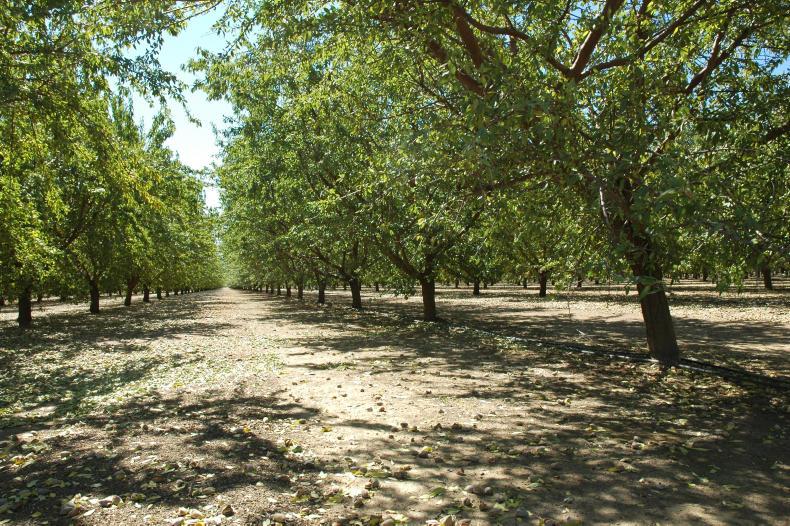September is a good month to visit California, particularly if you leave the busy freeways and take to the backroads of the rural towns and villages. The countryside roads around places such as Modesto, Turlock and Merced in California’s Central Valley are alive with activity as farmers begin the massive undertaking that is the annual harvest.
Combines are moving through maize fields to bring in this year’s maize silage crop, while alfalfa can also be seen baled in fields.
But if you spend any time in this unique part of the US you quickly notice the almond trees. They are everywhere you travel, planted in perfectly symmetrical rows stretching for miles along roads. The almond harvest for 2017 is just getting under way this month and will run well into November.
Growing almond trees has exploded in California over recent decades as prices have soared for the small nut produced by these trees. California now accounts for 80% of all of the world’s almond production as farmers have planted more and more acres in trees. In 2016, the acreage in California planted in almond trees increased 7% year on year to a record 1.24m acres, with about 940,000 acres of trees producing nuts.
From planting, it takes about three to four years before an almond tree will begin bearing an annual nut crop, with good production coming after five to six years.
California’s almond story is one of phenomenal growth but much of it has been at the cost of the state’s enormous dairy industry. The golden state is the largest milk producer in the US, with Californian dairy farmers pumping out a cumulative 17.7bn litres last year – about 20% of the entire US milk pool and more than double Ireland’s almost 7bn litre milk pool. Thanks to the plentiful availability of cheaper feed and protein sources, the cost of production in California has generally been the lowest in the US.
However, California’s dairy industry is starting a phase of real decline as the almond takeover marches on. Milk production in California is declining at a rate of 2% per annum, or 188m litres, as more dairy farmers exit the industry in favour of growing almond trees or other profitable nut crops such as walnuts and pistachios.
When visiting with many Californian dairy farmers over recent weeks the mood was noticeably dejected, despite the improvement in dairy markets over the past year.
Prins Dairy is a second-generation dairy farm just outside Modesto. Milking 600 cows on a 370 acre farm, Kevin Prins now runs the family farm after taking over the business from his father John, who moved from Minnesota in the 1970s to start on the farm.
“Right now, the returns from almonds are about three times that of dairying,” says Kevin Prins, who has seen many of his neighbours convert their dairy holdings over to almond trees.
Prins’ passion for dairy farming is clear as he shows off his three-way crossbred cow out of Holstein, Swedish Red and Montbeliarde, which are producing close to 34 litres per day. But with most dairy farmers such as the Prins surrounded on all sides with almond trees, there is almost an inescapable acceptance among dairy producers in California that the industry here is regressing.
In the nearby town of Ceres, Gary Marchy operates a 520-cow dairy farm on a 255ac block. While Marchy uses most of the land to grow corn silage, he has converted some of the land over to almonds in recent years.
“This year, I’ve just put about 40 acres into almonds,” says Marchy. “I just see the profits that will come from the almond crops as a hedge against my dairy business.”
While new ground is being stripped all the time for planting almond trees, it’s telling that there has not been a new dairy farm started in California since 2008. The collapse in dairy markets in 2009 and 2015/16 has left many highly borrowed Californian farmers with plenty of scars, meaning the profitability of almonds is very attractive.
The mood among dairy farmers in California today is succinctly summed up by Kevin Prins when he says: “Maybe I’ll end up an almond farmer by the time I retire. Who knows?”
Almond prices have increased since 2009 as consumers look to the health benefits of eating nuts. This has boosted consumption among the growing middle classes in developing countries such as China.
Coupled to this, in developed markets there is a growing interest in a Mediterranean diet with consumers which is also fuelling demand.
This rising demand has coincided with a multi-year drought and water shortage in California. This has raised questions about the sustainability of almond-growing in the State.
However, almonds which were previously categorised as a water-intensive crop, taking approximately one gallon of water to produce one almond, are now seen to consume less water than dairy cows or beef animals in the State.
It can take up to 143 gallons of water to produce one gallon of milk in California due to the large amount of water needed to grow the crops to feed the animals.






 This is a subscriber-only article
This is a subscriber-only article












SHARING OPTIONS: